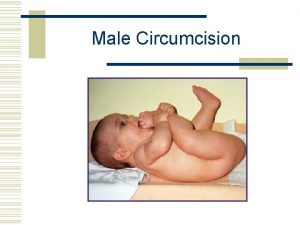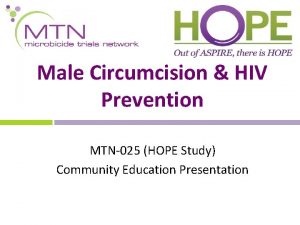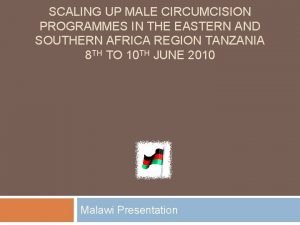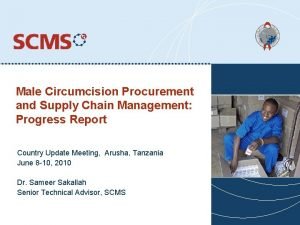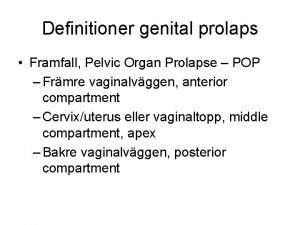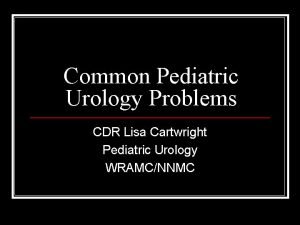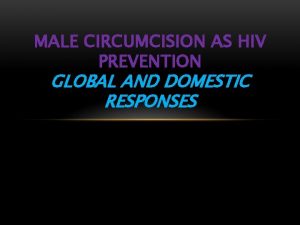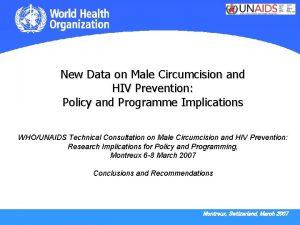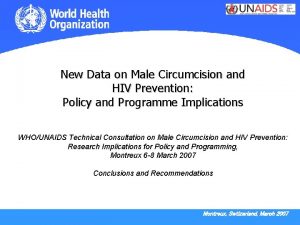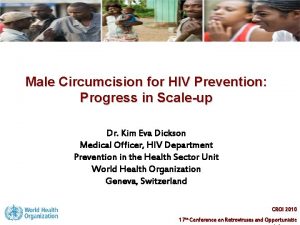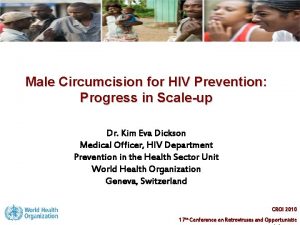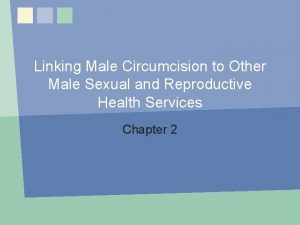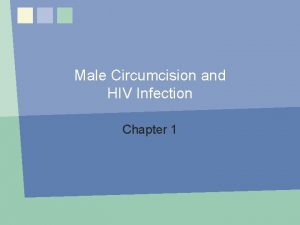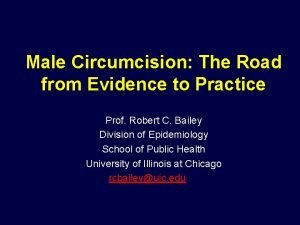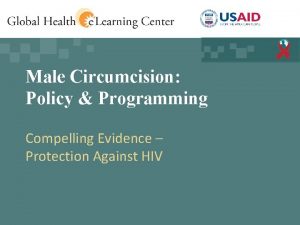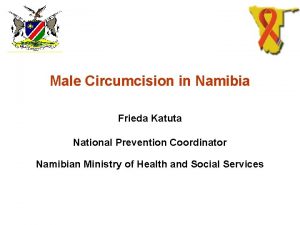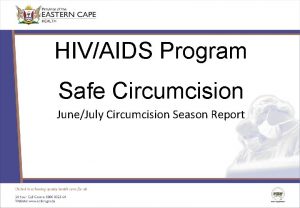Male Circumcision and HIV prevention the Evidence and


























- Slides: 26

Male Circumcision and HIV prevention, the Evidence and potential Impact on HIV incidence in Zimbabwe Update on Sexually Transmitted Infections Harare, 29 th of September 2009 Karin Hatzold, MD, MPH Director HIV Services PSI Zimbabwe

Overview • • Evidence MC for HIV prevention Evidence other benefits of MC Acceptability Risks and risk compensation MC and implications for women Population - level impact Cost-effectiveness Update on Zimbabwe MC program

Global Prevalence of Male Circumcision 665 million men or 30 % of the world’s male population are circumcised – 68% Muslims – 0. 8% Jewish – 13% US males

Male circumcision and HIV infection Bongaarts, AIDS 1989

HIV and MC Prevalence – Africa Adapted from Halperin & Bailey, Lancet 1999; 354: 1813 -1815 MC Prevalence < 20% MC Prevalence > 80%

Meta-analysis of prospective studies Weiss et al AIDS. 14(15): 2361 -2370, October 20, 2000. • Review of 27 observational studies from SSA • 21 showed reduced risk of HIV among circumcised men • Overall – Adjusted OR: 0. 42 (95% CI: 0. 34 to 0. 54) • Population-based studies – Adjusted* OR: 0. 57 (95% CI: 0. 47 to 0. 70) • High risk groups – Adjusted* OR: 0. 31 (95% CI: 0. 23 to 0. 42) *Including additional studies not included in published meta-analysis

How the foreskin increases risk of infection Thinly keratinized mucosal layer of inner foreskin - susceptible to minor trauma and abrasion - can facilitate entry of pathogens Area under foreskin is warm, moist environment, suitable for pathogen replication Mc. Coombe & Short, AIDS 2006 20: 1491 -1495

How the foreskin increases risk of HIV acquisition • Increased risk of genital ulcers in uncircumcised men èIncreased risk of HIV through disrupted mucosal surface of the ulcer • High density of HIV-1 target cells (Langerhans cells) in penis, and those in the inner foreskin are nearer the epithelial surface due to lack of keratin Mc. Coombe, AIDS, 2006 20 p. 1491 • Study of foreskin & cervical biopsies showed that inner foreskin is more easily infected with HIV than external foreskin, or cervical tissue Patterson Am J Pathol, 2002. 161 p. 867

Evidence for HIV risk reduction among circumcised men: 3 RCTs 3 randomized controlled trials comparing new HIV infections in men who were circumcised as part of the trial and men who were not circumcised Orange Farm South Africa Rakai Uganda Kisumu Kenya Semi-urban Rural Urban Male circumcision prevalence in population 20% 16% 10% HIV incidence 1. 6% 1. 0% 1. 6% 18 -24 yrs 15 -49 yrs 18 -24 yrs Sample size 3, 128 4, 996 2, 784 Protective effect (ITT) 60% 51% 53% Protective effect (as treated) 76% 55% 60% Population Age range of study participants Original source of slide (modified): Willard Cates/FHI

Evidence for HIV risk reduction among circumcised men, Kenya Study – Further Follow-up M 6 M 12 M 18 M 24 M 30 M 36 M 42 Total 24 Circumcised HIV At risk 7 3 1 8 2 1337 1313 1272 1233 724 532 277 12 17 9 10 7 6 4 1356 1320 1265 1208 694 476 245 Uncircumcised HIV At risk 65 HIV Incidence: Circumcised men 2. 6% Uncircumcised men 7. 4% Relative Risk: 0. 36 (0. 23, 0. 57) Bailey et al, International AIDS Conference Mexico, Aug 2008, LB

Male circumcision and risk of syphilis, chancroid, and genital herpes, Meta Analysis Weiss et al: Sex Transm Infect 2006; 82: 101– 110. • Substantially reduced risk of syphilis among circumcised men (RR = 0. 67, 95%, CI: 0. 54 to 0. 83) • Circumcised men at lower risk of chancroid (RRs: 0. 12 to 1. 11) 6 out of 7 studies • Borderline statistical significance for reduced risk of HSV-2 infection (RR = 0. 88, CI : 0. 77 to 1. 01) in circumcised men

Effect of circumcision on gonorrhea, trichomoniasis, and human papilloma virus (HPV) , sub-study RCT Orange Farm • Prevalence of high-risk HPV subtypes (new infections) after 21 months follow-up: – Control group – Intervention group – Prevalence ratio 24. 8% 15. 8% 0. 57 , CI: 0. 43 – 0. 75) P < 0. 001 • MC provides no protection against gonorrhea and borderline statistical significant protection against trichomoniasis Taljaard, International AIDS Conference Mexico, Aug 08, LB

Acceptability of Male Circumcision for Prevention of HIV/AIDS in Sub-Saharan Africa 2006: review of 13 acceptability studies in 9 sub-Saharan countries: Uncircumcised men for themselves: Women (for their partners): Men for their son: Women for their son: 65% (29 -87%) 69% (47 -79%) 71% (50 -90%) 81% (70 -90%) Westercamp, Bailey; AIDS Behav (2007) 11: 341– 355

Acceptability of Male Circumcision for Prevention of HIV/AIDS in Sub-Saharan Africa • Main barriers to acceptability were costs, fear of pain, safety concerns • Main facilitators of acceptability were hygiene, perceived lower risks of STIs and other health benefits • Culture and ethnicity are not major barriers to the acceptability Westercamp, Bailey; AIDS Behav (2007) 11: 341– 355

Adverse effects following MC Type of Complication Orange Farm, South Africa Kisumu, Kenya Pain 13 (0. 82%) Swelling or hematoma 10 (63%) Excessive bleeding 9 (0. 57%) Problems with appearance 9 (0. 57%) Other 5 (0. 32%) Damage to penis 4 (0. 25%) Insufficient skin removed 4(0. 25%) Infection 3 (0. 19%) 7 (1. 3%) Delayed wound healing 2 (0. 13%) 4 (0. 8%) Anesthetic complications 1 (0. 07%) 4 (0. 8%) Excessive swelling 1 (0. 2%) Erectile dysfunction 1 (0. 2%) TOTA L 60 (3. 8%) 17 (3. 5%) Source: Auvert et al, 2005 ( South Africa, Krieger et al. , 2005, Kenya)

Behavior Change after male circumcision Rakai : • No differences in sexual behavior during the trial by circumcision status Orange Farm: • Increased mean number of sexual acts between 4 and 21 months among men in the circumcision arm, • No increase in the number of sexual partners or change in condom use Kisumu: • Decline in reported risk taking behavior during 24 months follow-up in both arms • At 24 months significantly fewer men in control arm reported unprotected sex ( 46% versus 51%), • Control arm reported more likely consistent condom use (41% versus 36%), and practising abstinence at 24 months ( 18% versus 14%) Source: Weiss et al, AIDS 2008, 22: 567 -574

Benefits for women • Indirect benefits through reduction in HIV incidence among men who are circumcised • Lower risk of chancroid and syphilis infection • Lower risk of HPV infection and cervical cancer • Lower risk of bacterial vaginosis • Other indirect benefits through better opportunities of men for SRH education

Potential impact of male circumcision programs on women’s health • HIV acquisition • Risk compensation • Negotiating power and violence against women • Stigma, blame and discrimination • Resources and resource allocation

Mathematical Modeling The potential impact of male circumcision to prevent HIV transmission in Zimbabwe • HIV incidence could be reduced by 25% to 35% if 50% of men are circumcised • MC on its own not expected to lead to the terminal decline of the HIV epidemic in Zimbabwe • Over the first 30 years circumcising men aged between 20 to 29 years could lead to a greater reduction in HIV incidence • In the long-term, circumcising infants or boys (younger than 19 years of age) could lead to greater reductions in incidence; but no impact for the first 20 years • Men being circumcised should be encouraged to test for HIV − but no substantial dangers of increased incidence if infected men are circumcised

Number of new male circumcisions required for adults and neonates, 2009 -2030 Zimbabwe 1, 400 Figure 1: Number of New MC Required for Adults (15 -49) and Neonates (Thousands) 1, 200 800 Base 600 MC 400 200 0 20 05 20 06 20 07 20 08 20 09 20 10 20 11 20 12 20 13 20 14 20 15 20 16 20 17 20 18 20 19 20 20 20 21 20 22 20 23 20 24 20 25 20 26 20 27 20 28 20 29 20 30 Thousands 1, 000

New Infections Averted (Cumulative 2009 -2025)

Discounted Cost per Infection Averted (2009 -2025)

Key Messages Scaling up male circumcision to reach 80 percent of adult and newborn males in Zimbabwe by 2015 would: üavert almost 750, 000 adult HIV infections between 2009 and 2025 üyield total net savings of more than US$3. 8 billion between 2009 and 2025 ürequire more than 1. 1 million MCs in the peak scale-up year (2012)

MC Epidemiological Data Zimbabwe • HIV Prevalence of 15. 6% ( 2007 Estimates) • Geographic variations of MC prevalence DHS 2005 -2005 • National prevalence of 10. 3% • Distribution fairly uniform across the country exception of • Matabeleleand North 18. 8% • Mashonaland Central 5. 3%

Zimbabwe’s MC program √ MC policy developed √ MC Communication campaign √ Learning sites: Karanda Mission Hospital, Mutare Provincial Hospital (PPP), Stand-Alone site Bulawayo ( PSI managed), Manyame Airbase √ Established national training site (ZNFPC) and training program, TOT approach with cascade training √ National Training guidelines, MC kit and supplies system, M&E tools √ Referral system between HIV Testing and Counseling service providers and MC program √ Circumcised 1000 males at two sites since May 09

Thank You
 Biblical circumcision vs modern
Biblical circumcision vs modern Primary prevention secondary prevention tertiary prevention
Primary prevention secondary prevention tertiary prevention Male circumcision
Male circumcision Male circumcision
Male circumcision Male circumcision
Male circumcision Stakeholders in hiv prevention
Stakeholders in hiv prevention Global hiv prevention coalition
Global hiv prevention coalition Disadvantages of circumcision
Disadvantages of circumcision Circumcision
Circumcision Circumcision
Circumcision How to keep a pure heart
How to keep a pure heart Circumcision
Circumcision Framfall symtom
Framfall symtom Circumcision
Circumcision Circumcised
Circumcised Ptsd circumcision
Ptsd circumcision Circumcision
Circumcision Difference between class evidence and individual evidence
Difference between class evidence and individual evidence Primary evidence vs secondary evidence
Primary evidence vs secondary evidence Primary evidence vs secondary evidence
Primary evidence vs secondary evidence Secondary sources
Secondary sources Primary evidence vs secondary evidence
Primary evidence vs secondary evidence Jobs vancouver
Jobs vancouver Fiber evidence can have probative value
Fiber evidence can have probative value Class vs individual evidence
Class vs individual evidence Class vs individual evidence
Class vs individual evidence The absence of evidence is not the evidence of absence
The absence of evidence is not the evidence of absence


